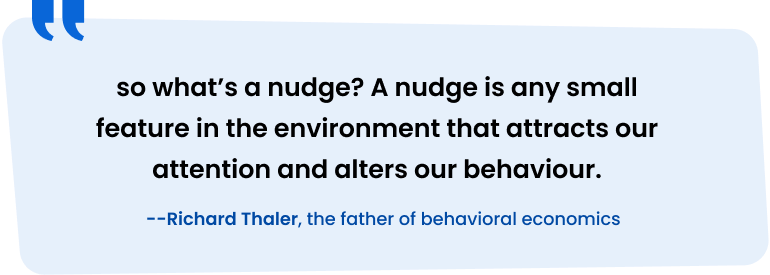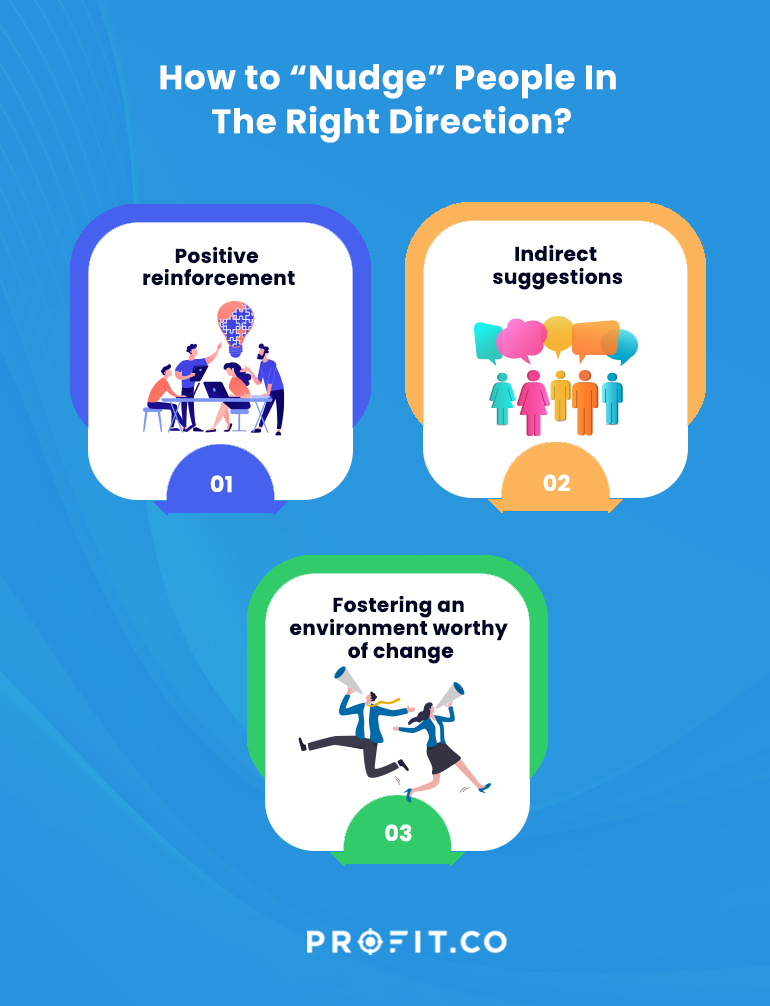The Nudge Theory was first known and popularized in 2008 through the book, Nudge: Improving Decisions About Health, Wealth, and Happiness. It is authored by two American scholars at the University of Chicago: behavioral economist Richard Thaler and legal scholar Cass Sunstein. Thaler and Sunstein built their work on the self-discovery model of Israeli-American psychologists Daniel Kahneman and Amos Tversky in the 1970s.
Since then, the theory has grown in population and usage, with organizational change or change management being its primary application today.
Let’s dive into this theory and how it can help your team with effective organizational change.
What is the Nudge Theory?
The Nudge Theory does not include lists or steps to instill organizational change. It is because the Nudge Theory fundamentally bases its argument that the acceptance of change should come from the members and not the leaders themselves.
The Nudge Theory framework is centered on positive reinforcement and indirect suggestions that will affect how people would respond. It means that instead of implementing change directly to the people, you foster an environment where they will think that change is desirable and worthy of their effort. This environment you set up will theoretically “nudge” them in the right direction.
While this is quite a more complicated theory because it does not have steps to follow (each organization and each situation will need a different strategy), it can be one of the most effective because change will come from the members themselves. Change Management in Behavioral Economics and Employee Engagement can easily apply the nudge theory mode and come out with effective change.

Examples of the Nudge Theory
In this theory, leaders usually use subtle policy shifts, behavioral tactics, and visual strategies to employ changes. To better understand this, here are some real-life examples of the Nudge Theory.
1. Spain’s Organ Donation Policy
Since the Spanish government wanted to increase their country’s organ donation rate, they did not directly call for more volunteers to sign up or mandate anyone to do anything. Instead, the government operates under an “opt-out” system, where people are automatically registered for organ donation unless they specifically state otherwise. It resulted in Spain being one of the world’s leaders in organ donation.
The Spanish government knew that increasing their organ donation rate could not be volunteer-led because people would forget to take the necessary steps to sign up or have distractions. Change needs to have a seamless procedure for people without personal gain. With an automatic registration system, individuals motivated to not participate would withdraw if necessary. People indifferent to organ donation, which is the majority, would remain in the registry out of convenience.
Ready to take your business to the next level with Profit.co?
2. Amsterdam’s Urinal Fly
In the 1990s, at the Schiphol Airport in Amsterdam, authorities wanted to implement cleaner bathrooms. As such, instead of directly asking males to reduce spillage in urinals or mandating people to do so, they put an image of a housefly in each urinal. This forces males to “target” the fly. Was this effective? The airport said this little trick helped reduce the spillage on male bathroom floors by 80%.
Authorities knew that the men needed to feel like they were initiating change for real change. Leading people to change is often more effective than telling them to change. Changing the environment to have the best conditions for change is an effective way to implement it, which is what the Dutch authorities succeeded in.

How Can it Be Applied in the Real World?
Because this theory tackles organizational change most indirectly, the nudge theory can work best in organizations that do not appreciate confrontation. Guidelines may be like in the school setting or an organization where trust and rapport for the leader are not fully built yet. They already have to introduce a change.
It can also help instill small behavioral changes in the organization, not the big technical transitions. Behavioral changes will work best with the nudge theory because it primarily uses reinforcement. It can also be used on more sensitive projects like fundraising.
Utilizing The Nudge Theory can help your team develop the desire to change are get ready to answer the question, are you ready for change? Nobody wants a tyrant, and by encouraging positive behavior, you can effectively drive everyone to want to achieve change.
Think of being a student in the classroom; students respond well to teachers encouraging and celebrating their achievements and good behavior. Students will wish to perform well if provided with positive reinforcement when they are achieving and indirect suggestions when they are misbehaving. This collaborative form of communication fosters a classroom environment where students want to achieve instead of being asked to.
FAQs
- What is the Nudge Theory?
The Nudge Theory is centered on positive reinforcement and indirect suggestions that will effectively behave how people would respond. It means that instead of implementing change directly to the people, you foster an environment where they will think that change is desirable and worthy of their effort. This environment you set up will theoretically “nudge” them in the right direction.
- What is an example of the Nudge Theory?
An example of The Nudge Theory would be rewarding a student’s positive behavior in a classroom setting with positive reinforcement. When the student misbehaves, instead of scolding them, you would make indirect suggestions about their poor behavior and highlight other students’ positive behavior. The positive reinforcement will drive the student to behave and be rewarded for doing so.
- How can i use the Nudge Theory to help my team?
You can use The Nudge Theory to foster an environment to motivate your team to change. You can encourage your team to make changes using positive reinforcement and indirect suggestions.
Conclusion
Nudging your team in the right direction can help your organization achieve effective change. Leaders require the skill of motivating others to change. The Nudge Theory helps refine that skill by providing the tools to foster and create lasting change. Your team can evolve and innovate successfully through positive reinforcement, indirect suggestions, and a nurturing environment.
